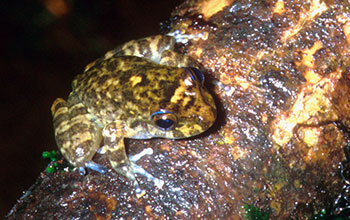Multimedia Gallery
Declining Frog Species (Image 2)
A Bob's robber frog (Craugastor punctariolus, in the family Craugastoridae). This picture was taken in 2002 near EI Cope, Panama, two years before the chytrid fungus outbreak. Today, the species not only may be extirpated from this location, but globally as well. Researchers are looking for populations of the species to find out its current status.
First noted when the golden toad and about half of the frog species disappeared in Monteverde reserve in Costa Rica in 1987, the killer fungus has been spreading eastward through the Central American highlands and also through a large portion of the Andes Mountains (likely from a separate introduction) ever since.
Researchers like Andrew J. Crawford, an associate professor in the department of biological sciences at the University of the Andes, Columbia, and a research associate at the Smithsonian Tropical Research Institute in Panama, are studying the decline in frog populations in parts of South America.
You can read more about the deadly chytrid fungus in the National Science Foundation press release "Frog Killer Caught in the Act." To learn more about Crawford's research and what you can do to help with frog species decline, visit his website Here.
[The fieldwork for this research was supported by National Science Foundation grants GEO 02-13851, DEB 02-34386, DEB 01-30273 and a Small Grant for Exploratory Research, IOS 99-96355.] (Date of Image: 2002) [Image 2 of 3 related images. See Image 3.]
SORRY: THIS IMAGE IS NOT AVAILABLE IN HIGH RESOLUTION FORMAT
Credit: Andrew J. Crawford, Universidad de los Andes
Images and other media in the National Science Foundation Multimedia Gallery are available for use in print and electronic material by NSF employees, members of the media, university staff, teachers and the general public. All media in the gallery are intended for personal, educational and nonprofit/non-commercial use only.
Images credited to the National Science Foundation, a federal agency, are in the public domain. The images were created by employees of the United States Government as part of their official duties or prepared by contractors as "works for hire" for NSF. You may freely use NSF-credited images and, at your discretion, credit NSF with a "Courtesy: National Science Foundation" notation.
Additional information about general usage can be found in Conditions.
Also Available:
Download the high-resolution JPG version of the image. (436 KB)
Use your mouse to right-click (Mac users may need to Ctrl-click) the link above and choose the option that will save the file or target to your computer.



